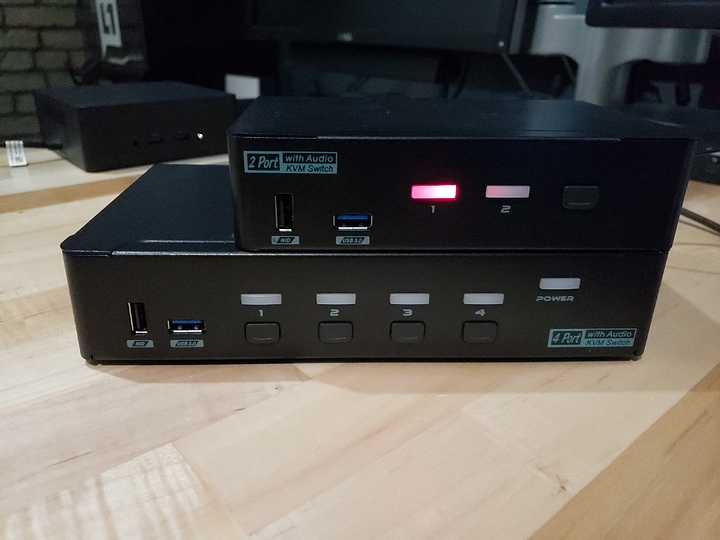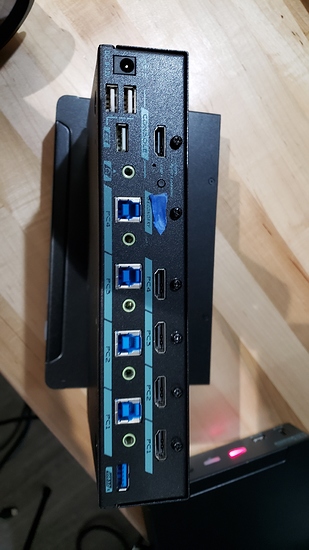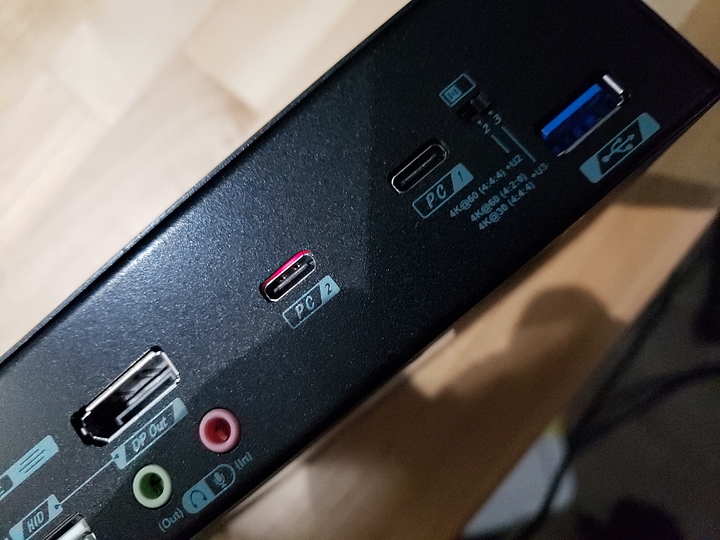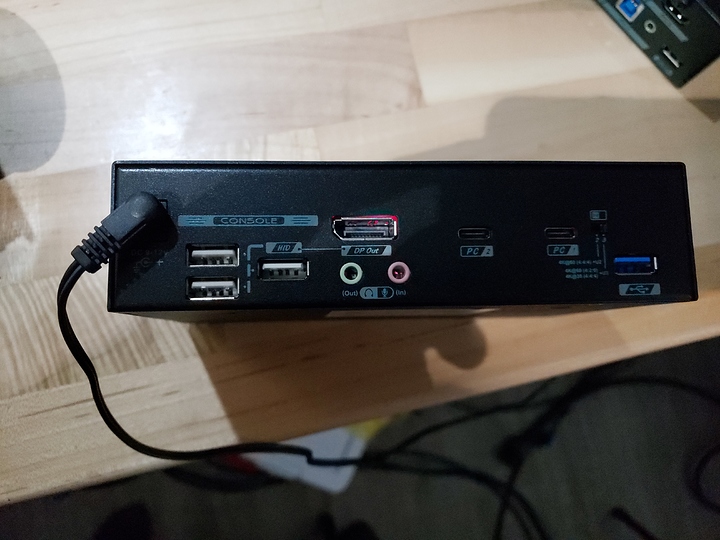New Level1Techs KVMS?!!?!?!
Two models even!
*Two Port, One monitor USBc KVM
*Four Port, One monitor HDMI ( 4k @60hz) KVM
HDMI KVM!?!?
This KVM is essentially the same as our DP KVM but with HDMI instead of DP. Note that HDMI is just a bit less bandwidth than DP, but this supports HDMI 2.0/full spec/HDCP Passthrough and all that.
As with the DP KVM, when toggling inputs it disconnects the monitor from attached PCs and re-attaches it. Other options seem to introduce latency and gamers don’t like that.
Other than being HDMI instead of DP, no big changes here. USB3 (1 front/1 rear).
Two Port, One Monitor USB-C KVM
Apple products can be so terrible to work with. The trashcan Mac Pro requires a DP repeater but it does work with the Level1Techs One/Two Monitor KVM.
Background
Many laptops today have DP over USBc or DP over Thunderbolt and those can be problematic as well. In general most people have had very good success – probably the Level1Techs KVM is about the best KVM you can buy – but it’s not perfect. (So We Keep Going, right?)
Enter the Level1Techs USBc KVM. USBc/TB doesn’t play by the rules. It’s not a lot of fun. This KVM is generally the one you want for that situation. It’s been battle-tested on Macbook Pros with USBc and it works really well. Again, like the DP KVM there are some things you need to know to elevate your understanding of the situation because the fact that you need this hardware means that you are not, oh no, a normie.
What is this magical device?
So the Level1Techs USBc KVM has two USBc inputs. There is a physical switch on the KVM to toggle between “give all the bandwidth to display, damn the USB (if necessary)” and “damn the display, I will have my USB3 bandwidth”. This switch is also important for some phones that can use external displays (more on that in a sec).
We also have analog audio out + mic in. I had hoped the analog audio out + mic in would turn out a bit better. Don’t rely on the audio – a USB dac will work far better – but it’s there if you want to experiment.
There are 3 USB HID ports and 2 USB 3.0 ports (one front, one rear).
Where and When can I get one?
This KVM, and the new four port/One Monitor HDMI (4k@60) KVMs are up for PREORDER at https://store.level1techs.com/
NOTE: It’s going to take 2-3 business days before the DP orders start shipping. The USBc and HDMI orders are preorders and will take much longer before they ship, details here and on the store.
What’s this going to cost me?
TBD. The USBc KVM is likely to be the least expensive KVM we will ever have. They aren’t cheap. They aren’t perfect. But they’re pretty darn good.
We are going to take preorders until April 22, then I will queue up a big order of the # of preorders plus 15-20%. It will take 4-6 weeks for assembly and testing. The pre-orders would start to ship around the week 2 or 3 of June. So if you pre-order you are guaranteed to get whatever you pre-order but it’s going to take a little bit for it to come. This is how we did it with the DP KVMs because I wasn’t sure what the demand would be and I think everyone would agree that we handled that really well. So we’re going to do that with the USBc and HDMI KVMs.
(The DP KVMs for single and dual monitor are in stock as of 2019-04-07 and orders of those will ship within 2-3 business days of ordering).
TODO: Add Links.
Darn, I already bought the DP KVM Last Year
Good news. You can use both USBc + DP KVMs at the same time!
The good news is that you can daisy chain/slave your USBc KVM to your DP KVM. How cool is that?
We have had the DP KVMs in stock for a while but I didn’t want to sell them until I could be confident the issues with earlier prototypes had been worked out. The production models + latest firmware are AWESOME. Better than ever. So I didn’t want to restock then a few weeks later say “surprise! new KVMs!” but we were waiting on some brand spankin new USBc silicon to confirm that some show-stopping issues would be fixed.
Slave a USBc KVM from a DP KVM
The input buttons obviously work fine. You want to use a short and high quality DP<>DP cable to connect the USBc KVM to the DP KVM. I recommend input #4 on the DP KVM. Just stack 'em. USB out on USBc KVM can go right to the input. Note I do not recommend passing through USB3 devices plugged in to just the USBc KVM if you do this. It works mostly, but it’s USB not a Christmas Tree.
If you want keyboard control, that’s doable, but a bit weird. So the trick here is that double tapping scroll lock or double tapping control and 1-4 will let you switch inputs 1-4 on a DP KVM by default. You can double tap scroll lock, then control, to disable control-control-num on ONE of the KVMs. It beeps once or twice to let you know whether the ctrl-ctrl hotkey is enabled.
The HID signals will then pass through to the other KVM. As such you can control each KVM with an independent key sequence.
Of course you can also just hit input # on the DP KVM then input # on the USBc KVM, and that’s fine too.
Haha, what about my USBc phone? Lulz?
Guess what? You can use USBc with your phone, probably, if you’re asking about this. Every phone is different and some require the USB-priority mode switch (Note: DO NOT switch modes while switch power is on! Nooooo!) so you’ll be limited to DP 4k 4:2:0 in that case… but yeah, it works. You can “Dock” your phone to a full size display/mouse/keyboard. It actually works really well on Samsung devices – shockingly well – todo put in Samsung DeX video here.
Other Notes
Note that the KVM doesn’t have any USB Power Delivery capability. It can’t even charge a USBc phone while mirroring the display. So don’t expect that. The KVM would have to handle “housefire” levels of power, which takes a long time and $$$$ so let’s not worry about that for now.
It’s taken forever to get the firmware just right. You’re welcome ![]()
As with the DP KVM, when toggling inputs it disconnects the monitor from attached PCs and re-attaches it. Other options seem to introduce latency and gamers don’t like that.
CABLES Note best to use thunderbolt cables even though it isn’t thunderbolt.
You will get a big black nothing on the display if you use common usbc to USBc cables. This is because the wires for display and the wires for usb are different and not every USBc cable will do anything other than USBc. Even usb2/3 is in the cable. It’s weird. Not the kvm if you get cheap crappy cables that don’t have all the wires or are out of spec.
TODO: going to add lots of pics here in a sec.





